Title: Understanding the Mechanics of AI-Generated Drawings
In recent years, the development of artificial intelligence (AI) has led to remarkable advancements in various fields, including art and creativity. One notable application of AI in the realm of art is the generation of drawings, where sophisticated algorithms are employed to produce visually stunning and intricate artworks. But how exactly do AI drawings work, and what are the mechanics behind this innovative technology?
At its core, AI-generated drawings rely on an approach known as generative adversarial networks (GANs), which involves two neural network models – a generator and a discriminator – working in tandem to create realistic and detailed images. The generator is responsible for producing the drawings, while the discriminator evaluates the generated images to determine their authenticity. Through a continuous process of feedback and refinement, these models collaborate to iteratively improve the quality of the generated drawings.
So, what happens during the process of generating a drawing using AI? Initially, the generator model starts with random noise as input and gradually refines it to produce an image that resembles the desired output. The discriminator then assesses the generated drawing, providing feedback to the generator to guide its refinement process. This feedback loop continues until the generator successfully produces drawings that are visually indistinguishable from those created by human artists.
A key aspect of AI-generated drawings is the utilization of a vast dataset of existing artwork to train the neural network models. By analyzing and learning from a diverse range of drawings, paintings, and sketches, the AI models can capture the intricate details, styles, and nuances of different artistic expressions. This training process enables the AI to understand and replicate various artistic elements, such as line strokes, shading, textures, and color palettes, thereby enhancing the realism and creativity of the generated drawings.
Furthermore, AI-generated drawings can be influenced by specific input or prompts provided by users, allowing for personalized and customizable outputs. Through the use of conditional GANs, users can input parameters, keywords, or even rough sketches to steer the direction of the generated drawings. This interactive aspect empowers individuals to collaborate with AI in the creative process, enabling a fusion of human creativity and AI capabilities.
The implications of AI-generated drawings extend beyond mere artistic novelty. These AI-driven tools have the potential to revolutionize creative workflows, offering artists and designers new avenues for inspiration, exploration, and ideation. Moreover, the democratization of art through AI allows individuals with varying degrees of artistic skill to access powerful tools that can aid in the manifestation of their creative visions.
However, it is important to recognize the ethical considerations related to AI-generated drawings, particularly in terms of plagiarism, copyright, and the potential devaluation of human artistic expression. As AI continues to evolve, it is essential for society to engage in conversations about the ethical, legal, and cultural implications of AI-created art.
In conclusion, the mechanics of AI-generated drawings are driven by sophisticated algorithms, neural network models, and a rich dataset of artistic examples. By leveraging the power of GANs and training on extensive artistic libraries, AI can produce visually compelling and diverse drawings. As AI technologies continue to advance, the future of AI-generated drawings holds promise for transforming the landscape of art, creativity, and human-AI collaboration.
